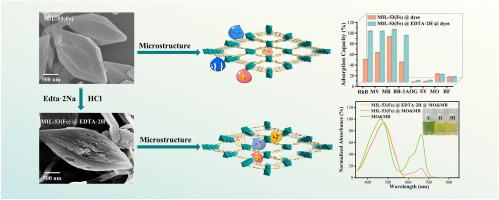A hierarchically porous MOF engineered via chelation-etching for high-capacity selective dye adsorption
IF 3.5
3区 化学
Q2 CHEMISTRY, INORGANIC & NUCLEAR
引用次数: 0
Abstract
Porous metal-organic frameworks (MOFs) are attractive candidates for selective adsorption of water pollutants due to abundant functional groups and tunable electrical properties, yet their microporous nature limits the maximum adsorption capacity. While larger-pore MOFs face synthetic, cost and stability constraints, hierarchically porous architectures offer promising solutions. This work reports a chelation-etching strategy to convert microporous MIL-53(Fe) into a hierarchically porous composite (MIL-53(Fe)@EDTA·2H) using 100 mM HCl/EDTA. The etched framework owns hierarchical porosity (5–50 Å), where mesopores coexist with preserved micropores. Compared to pristine MIL-53(Fe), the composite exhibits enhanced adsorption amount for cationic dyes in mixed systems, attributed to the electrostatic interactions and improved pore volumes. MIL-53(Fe)@EDTA·2H achieves a methylene blue (MB) adsorption capacity of 196.72 mg g−1, which is approximately twice that of the parent MOF. To mitigate adsorbent leaching during recovery, polyvinylidene fluoride (PVDF) mixed matrix membranes (MIL-53(Fe)@EDTA·2H·M) were fabricated, effectively immobilizing particles while maintaining performance. This study establishes a controlled etching approach for engineering hierarchical porosity in MOFs and demonstrates their utility as ideal adsorbents of both high adsorption capacity and selectivity.

一种通过螯合蚀刻设计的分层多孔MOF,用于高容量选择性染料吸附
多孔金属有机框架(mof)由于其丰富的官能团和可调的电性能而成为选择性吸附水污染物的有吸引力的候选材料,但其微孔性质限制了其最大吸附能力。虽然大孔径mof面临合成、成本和稳定性方面的限制,但分层多孔结构提供了有前途的解决方案。本研究报告了一种螯合蚀刻策略,使用100 mM HCl/EDTA将微孔MIL-53(Fe)转化为分层多孔复合材料(MIL-53(Fe)@EDTA·2H)。蚀刻框架具有分层孔隙度(5-50 Å),其中中孔与保存的微孔共存。与原始MIL-53(Fe)相比,复合材料在混合体系中对阳离子染料的吸附量增加,这是由于静电相互作用和孔隙体积的增加。MIL-53(Fe)@EDTA·2H对亚甲基蓝(MB)的吸附量为196.72 mg g−1,约为母体MOF的2倍。为了减轻吸附剂在回收过程中的浸出,制备了聚偏氟乙烯(PVDF)混合基质膜(MIL-53(Fe)@EDTA·2H·M),有效地固定了颗粒,同时保持了性能。本研究建立了一种控制蚀刻的方法来处理mof的分层孔隙度,并证明了它们作为高吸附容量和选择性的理想吸附剂的实用性。
本文章由计算机程序翻译,如有差异,请以英文原文为准。
求助全文
约1分钟内获得全文
求助全文
来源期刊

Journal of Solid State Chemistry
化学-无机化学与核化学
CiteScore
6.00
自引率
9.10%
发文量
848
审稿时长
25 days
期刊介绍:
Covering major developments in the field of solid state chemistry and related areas such as ceramics and amorphous materials, the Journal of Solid State Chemistry features studies of chemical, structural, thermodynamic, electronic, magnetic, and optical properties and processes in solids.
 求助内容:
求助内容: 应助结果提醒方式:
应助结果提醒方式:


